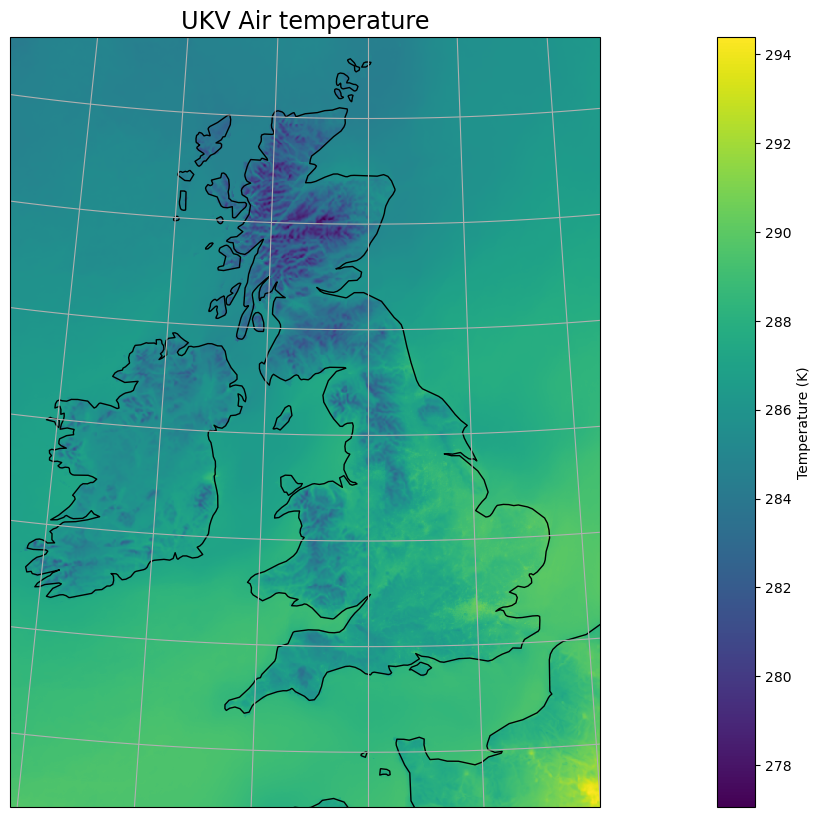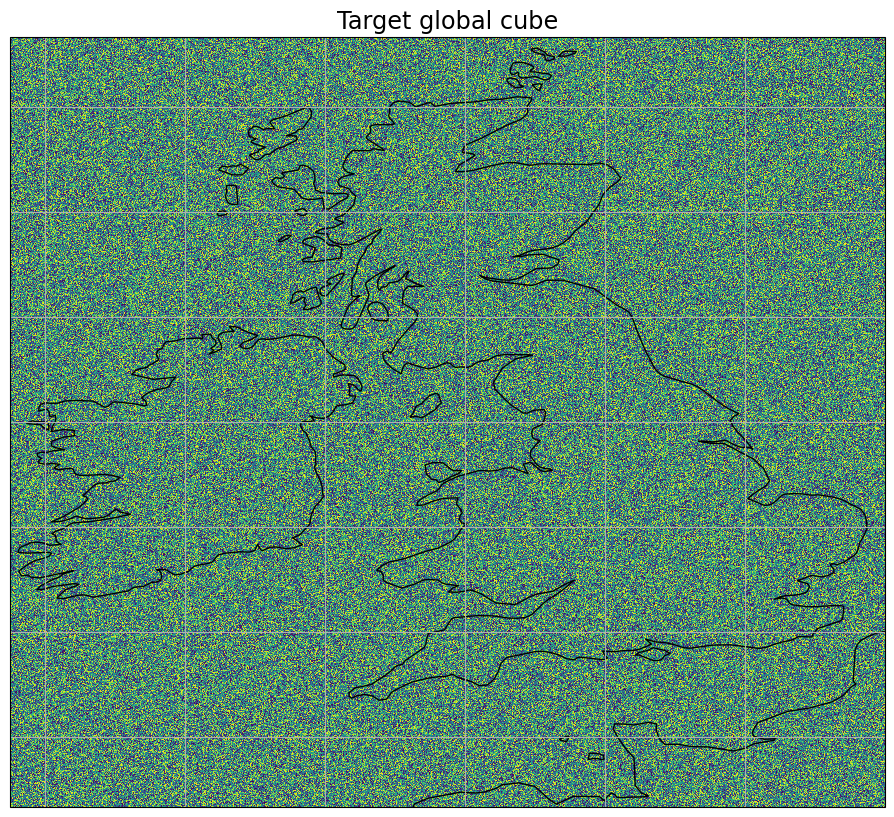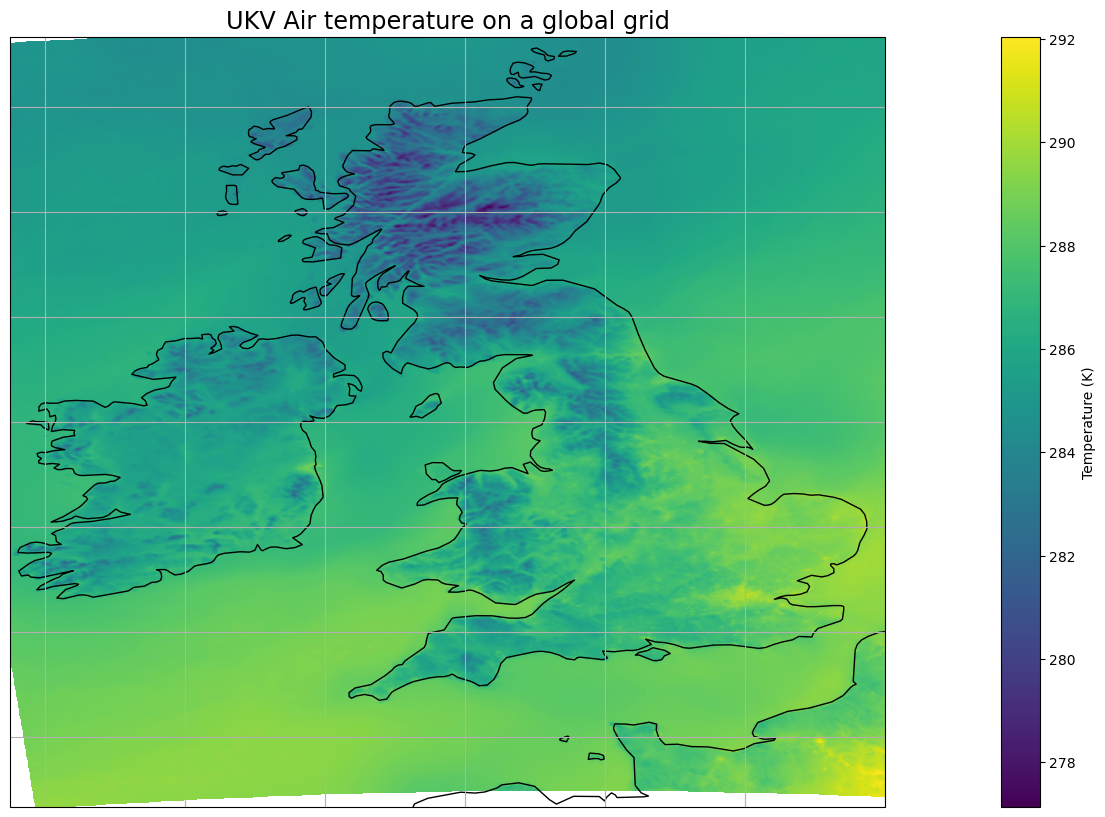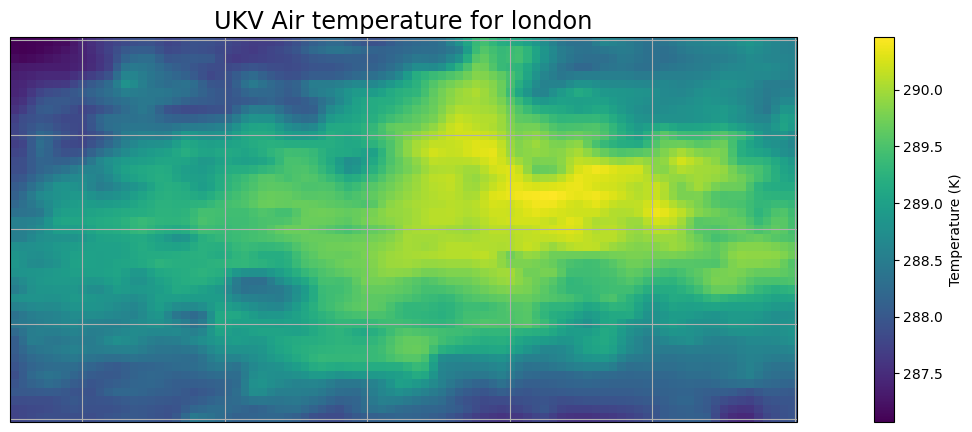Met Office UKV high-resolution atmosphere model data#
Urban Exploration Standard Python
Context#
Purpose#
To load, plot, regrid and extract an urban region from the UKV gridded model data using the Iris package.
Sensor description#
Met Office UKV model data is fairly high resolution (approximately 1 km horizontal) and available over the whole of the UK for a variety of atmospheric variables at surface and pressure levels. A selection of variables has been made openly available as part of the Met Office contribution to the COVID 19 modelling effort. A selection of variables at hourly and daily frequency in NetCDF format can be obtained from this landing page.
This notebook uses a single sample data file for 1.5 m temperature included with the notebook.
Highlights#
Data for the whole UK is loaded and plotted using Iris
Data is regridded to a geographic projection
A region over London is extracted
Contributions#
Notebook#
Dataset originator/creator#
Met Office Informatics Lab (creator)
Microsoft (support)
European Regional Development Fund (support)
Dataset documentation#
Theo McCaie. Met office and partners offer data and compute platform for covid-19 researchers. URL: https://medium.com/informatics-lab/met-office-and-partners-offer-data-and-compute-platform-for-covid-19-researchers-83848ac55f5f.
Note
Note this data should be used only for non-commercial purposes.
Install and load libraries#
Show code cell source
import os
import iris
import iris.analysis
import iris.plot as iplt
from iris.coords import DimCoord
from iris.coord_systems import GeogCS
from iris.cube import Cube
from iris.fileformats.pp import EARTH_RADIUS
import requests
import urllib.request
import pooch
import numpy as np
import matplotlib.pyplot as plt
import warnings
warnings.filterwarnings(action='ignore')
%matplotlib inline
Set project structure#
notebook_folder = './notebook'
if not os.path.exists(notebook_folder):
os.makedirs(notebook_folder)
Retrieve and load a sample data file#
filepath = 'https://metdatasa.blob.core.windows.net/covid19-response-non-commercial/metoffice_ukv_daily/t1o5m_mean/'
filename = 'ukv_daily_t1o5m_mean_20150801.nc'
response = requests.get(filepath+filename)
if response.status_code == 200:
urllib.request.urlretrieve(filepath+filename, os.path.join(notebook_folder, filename))
else:
pooch.retrieve(
url="doi:10.5281/zenodo.7087009/ukv_daily_t1o5m_mean_20150801.nc",
known_hash="md5:b71e092ead092f419f12073ddf2d3256",
path=notebook_folder,
fname="ukv_daily_t1o5m_mean_20150801.nc"
)
Downloading data from 'doi:10.5281/zenodo.7087009/ukv_daily_t1o5m_mean_20150801.nc' to file '/home/jovyan/notebook/ukv_daily_t1o5m_mean_20150801.nc'.
air_temp = iris.load_cube(os.path.join(notebook_folder, filename))
air_temp.coord('grid_latitude').guess_bounds()
air_temp.coord('grid_longitude').guess_bounds()
Visualisation#
Here we use the Iris wrapper to matplotlib pyplot to plot the gridded data with added gridlines and coastline.
Show code cell source
plt.figure(figsize=(30, 10))
iplt.pcolormesh(air_temp)
plt.title("UKV Air temperature", fontsize="xx-large")
cbar = plt.colorbar()
cbar.set_label('Temperature (' + str(air_temp.units) + ')')
ax = plt.gca()
ax.coastlines(resolution="50m")
ax.gridlines()
<cartopy.mpl.gridliner.Gridliner at 0x7f83ce84f4c0>

Regridding from Azimuthal equal-area projection to geographic#
Create a target cube with a lat-lon coord system for regrid#
It is filled with random data so we can plot it to check it looks correct.
latitude = DimCoord(np.linspace(48.5, 59.5, 1222),
standard_name='latitude',
coord_system = GeogCS(EARTH_RADIUS),
units='degrees')
longitude = DimCoord(np.linspace(-10.5, 2.0, 1389),
standard_name='longitude',
coord_system = GeogCS(EARTH_RADIUS),
units='degrees')
global_cube = Cube(np.random.uniform(low=0.0, high=1.0, size=(1222, 1389)),
dim_coords_and_dims=[(latitude, 0),
(longitude, 1)])
global_cube.coord('latitude').guess_bounds()
global_cube.coord('longitude').guess_bounds()
Show code cell source
plt.figure(figsize=(30, 10))
iplt.pcolormesh(global_cube)
plt.title("Target global cube", fontsize="xx-large")
ax = plt.gca()
ax.coastlines(resolution="50m")
ax.gridlines()
<cartopy.mpl.gridliner.Gridliner at 0x7f83ce712a60>

Perform the regridding from source data cube to target cube#
# Note we need to use extrapolation masking in case regridded source data is actually smaller
# than the target cube extents
global_air_temp = air_temp.regrid(global_cube, iris.analysis.Linear(extrapolation_mode="mask"))
Plot the regridded data to check it is correct#
Show code cell source
plt.figure(figsize=(30, 10))
iplt.pcolormesh(global_air_temp)
plt.title("UKV Air temperature on a global grid", fontsize="xx-large")
cbar = plt.colorbar()
cbar.set_label('Temperature (' + str(global_air_temp.units) + ')')
ax = plt.gca()
ax.coastlines(resolution="50m")
ax.gridlines()
<cartopy.mpl.gridliner.Gridliner at 0x7f83ce4e1ca0>

Extract the London Region#
Use the Iris Intersection method and supply the region lat-lon bounds#
min_lon = -0.52
min_lat = 51.3
max_lon = 0.3
max_lat = 51.7
air_temp_london = global_air_temp.intersection(longitude=(min_lon, max_lon), latitude=(min_lat, max_lat))
Plot the results#
Show code cell source
plt.figure(figsize=(20, 5))
iplt.pcolormesh(air_temp_london)
plt.title("UKV Air temperature for london", fontsize="xx-large")
cbar = plt.colorbar()
cbar.set_label('Temperature (' + str(air_temp_london.units) + ')')
ax = plt.gca()
ax.coastlines(resolution="50m")
ax.gridlines()
plt.show()

Save as a new NetCDF file#
iris.save(air_temp_london, os.path.join(notebook_folder,'ukv_london_sample.nc'))
Summary#
This notebook has demonstrated the use of the Iris package to easily load, plot and manipulate gridded environmental NetCDF data.
Citing this Notebook#
Please see CITATION.cff for the full citation information. The citation file can be exported to APA or BibTex formats (learn more here).
Additional information#
License: The code in this notebook is licensed under the MIT License. The Environmental Data Science book is licensed under the Creative Commons by Attribution 4.0 license. See further details here.
Contact: If you have any suggestion or report an issue with this notebook, feel free to create an issue or send a direct message to environmental.ds.book@gmail.com.
Notebook repository version: v1.0.7
Last tested: 2024-03-11




